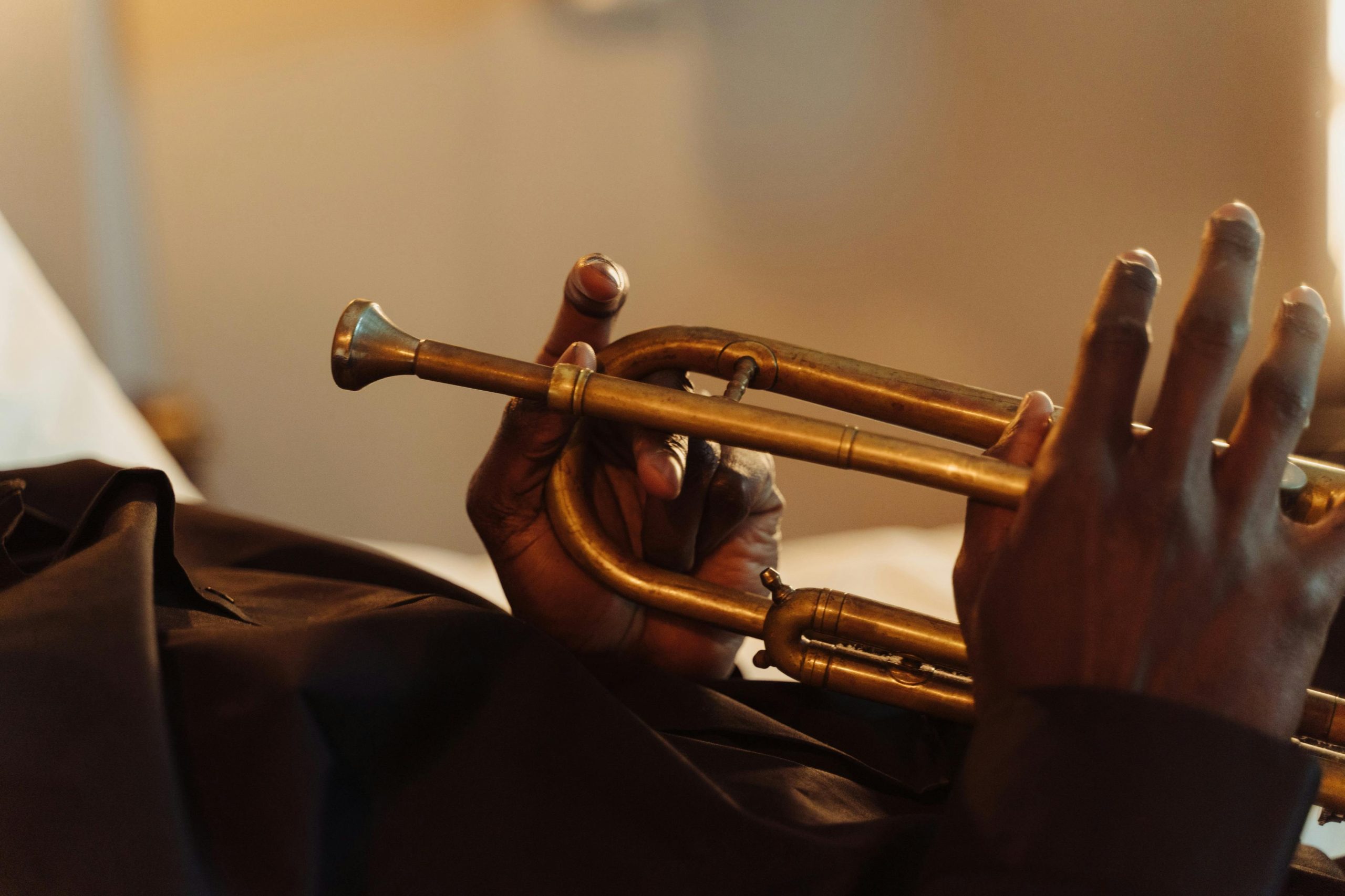This article contains affiliate links. Learn more.
From orchestral masterpieces to jazz solos, the trumpet’s distinctive sound has captivated listeners for centuries. This remarkable brass instrument produces its powerful, bright tone through a fascinating combination of physics, craftsmanship, and player technique. Understanding how trumpets work not only enhances appreciation for the instrument but also helps players develop better control and sound production.
This article explores the fundamental principles behind trumpet function, from basic acoustic concepts to the intricate mechanical systems that allow musicians to create such expressive performances. Whether you’re a curious listener, a beginning trumpet player, or someone looking to deepen their understanding of brass instruments, this exploration of trumpet mechanics provides valuable insights into one of music’s most enduring instruments.
If you are a beginner, check out our article over the best beginner trumpets.
Table of Contents
- 1 The Basic Structure of a Trumpet
- 2 The Physics of Sound Production
- 3 How Trumpet Valves Function
- 4 The Role of the Mouthpiece
- 5 The Overtone Series and Trumpet Harmonics
- 6 The Importance of Trumpet Tuning Slides
- 7 The Bell’s Acoustic Function
- 8 Different Types of Trumpets and Their Mechanics
- 9 How Playing Technique Affects Sound Production
- 10 The Evolution of Trumpet Design
- 11 Acoustic Challenges in Trumpet Design
- 12 Trumpet Care and Its Impact on Function
- 13 How Trumpets Compare to Other Brass Instruments
- 14 Trumpet Acoustics in Different Performance Spaces
- 15 The Future of Trumpet Design
- 16 Conclusion
The Basic Structure of a Trumpet

Shown above: Bach Stradivarius Trumpet
At first glance, a trumpet appears deceptively simple—a brass tube with three valves and a flared bell. However, this seemingly straightforward design conceals sophisticated engineering that enables its remarkable tonal capabilities.
The standard Bb trumpet consists of approximately 4.5 feet of brass tubing that has been carefully bent into a compact shape. According to the Acoustical Society of America, this specific length determines the trumpet’s fundamental pitch and overtone series. The instrument begins with the mouthpiece receiver, where the detachable mouthpiece connects to the main instrument. The tubing then continues through the leadpipe into the main slide, through the valve assemblies, around the tuning slide, and finally terminates at the bell.
Each component serves a specific acoustic purpose. The mouthpiece, with its cup-shaped interior and narrow throat, helps convert the player’s buzzing lips into acoustical energy that travels through the instrument. The gradually expanding taper of the tubing amplifies this initial vibration, while the valves provide a mechanism for altering the effective length of the air column. The bell’s distinctive flare efficiently transfers the sound waves to the surrounding air, projecting the trumpet’s sound outward.
The material composition also influences the instrument’s sound characteristics. Most professional trumpets are crafted from yellow brass (70% copper, 30% zinc), though variations like gold brass (85% copper, 15% zinc) and silver-plated models offer slightly different tonal colors. According to research from the International Trumpet Guild, these material differences affect not only timbre but also playing resistance and response.
The Physics of Sound Production
Trumpet sound production relies on fundamental acoustic principles that transform a player’s lip vibrations into musical tones. Understanding this process reveals why trumpets sound the way they do.
At its core, the trumpet functions as an acoustical amplifier and resonator. When a player buzzes their lips against the mouthpiece, they create a rapid opening and closing of the lips that produces a series of air pressure pulses. These vibrations alone would be barely audible, but the trumpet’s tubing selectively amplifies certain frequencies while dampening others. According to research published in the Journal of the Acoustical Society of America, this selective resonance is what gives the trumpet its characteristic timbre.
The scientific principle at work is known as standing wave resonance. As the lip-generated sound waves travel through the trumpet, they reflect at the bell and other points of acoustical impedance. When the frequency of the player’s lip vibration matches one of the trumpet’s natural resonant frequencies, standing waves form within the instrument. These standing waves reinforce each other, creating a strong, stable tone at that frequency.
The trumpet’s acoustical properties follow the harmonic series, a sequence of notes that occurs naturally in physics. By adjusting their lip tension and air speed (collectively known as the embouchure), players can access different notes in this series. According to The Physics of Music and Color by Leon Gunther, this relationship between lip vibration frequency and instrument resonance explains why brass instruments naturally produce certain notes more easily than others.
How Trumpet Valves Function
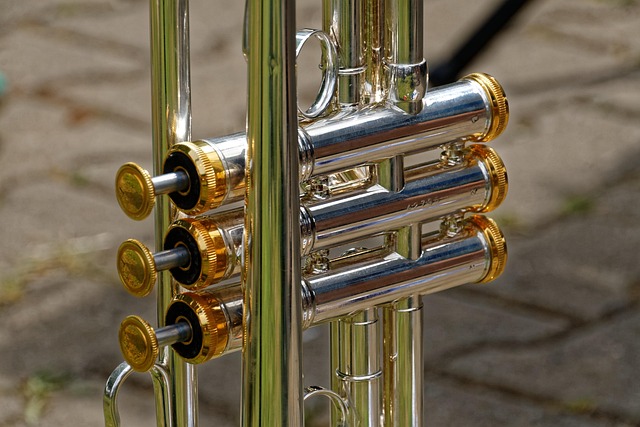
The valve system represents one of the most significant innovations in brass instrument design, transforming trumpets from limited natural instruments to fully chromatic ones capable of playing in any key.
Modern trumpets typically feature three piston valves, each controlling an additional length of tubing. When depressed, these valves redirect airflow through supplementary tubes (called valve slides), effectively lengthening the instrument and lowering its pitch. According to the Vienna Symphonic Library, this system was developed in the early 19th century and revolutionized brass playing by enabling chromatic note production.
Each valve lowers the pitch by a specific interval: the first valve lowers the pitch by a whole tone (two semitones), the second valve by a semitone, and the third valve by one and a half tones (three semitones). By using these valves individually or in combination, players can access all twelve semitones within an octave. For example, pressing the first and third valves simultaneously adds enough length to lower the pitch by five semitones.
Mechanical precision is crucial for valve function. Each valve must move smoothly and create a perfect seal when depressed, ensuring that air flows only through the intended pathway. The Yamaha Musical Instrument Guide explains that professional trumpets feature precision-machined valves made from materials like monel (a nickel-copper alloy) that resist corrosion and maintain tight tolerances even after years of use.
The valve system does introduce certain intonation compromises. Because the mathematical relationship between tube length and pitch isn’t perfectly linear, some valve combinations produce notes that are slightly sharp or flat. Skilled players compensate for these inherent intonation issues through subtle adjustments in embouchure or by using the tuning slides on specific valve combinations.
The Role of the Mouthpiece
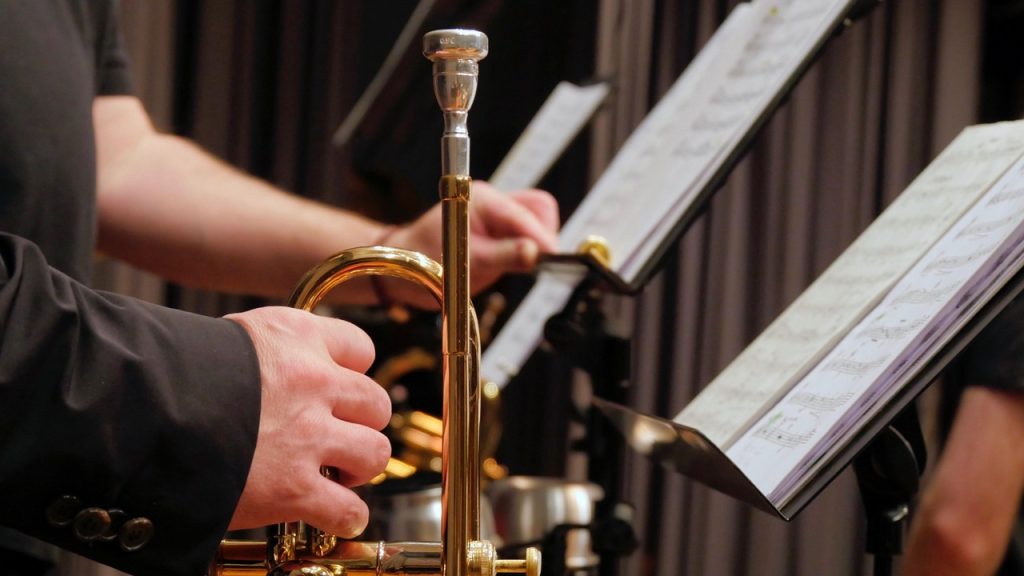
The mouthpiece serves as the critical interface between player and instrument, significantly influencing both playability and sound quality. Its design features several components that work together to shape the trumpet’s voice.
The cup is the concave section where the player places their lips. Cup depth and shape dramatically affect tone quality—shallow cups generally produce brighter, more projecting sounds favored in commercial music, while deeper cups yield darker, more symphonic tones. The International Trumpet Guild Journal has published numerous studies confirming that cup design is perhaps the single most influential factor in determining a trumpet’s timbre aside from player technique.
The throat (or bore) is the narrow opening at the bottom of the cup that leads into the backbore. This constriction plays a crucial role in creating the appropriate resistance for efficient energy transfer. The backbore then gradually expands, guiding the sound waves toward the main trumpet tubing. According to research by acoustician Arthur Benade, these internal contours significantly affect playing resistance, response, and tonal center.
The rim contour influences player comfort and endurance. A rounded rim generally offers more comfort for extended playing but less precision, while a sharper rim provides more defined feedback but may cause fatigue sooner. The rim width also matters—wider rims distribute pressure over a larger area but may limit flexibility, while narrower rims enhance flexibility but concentrate pressure on a smaller portion of the lips.
Players often experiment with different mouthpiece designs to find the optimal balance between their physiological characteristics, playing style, and musical requirements. The relationship between mouthpiece and player is highly personalized, with many professional trumpeters owning multiple mouthpieces for different musical contexts.
The Overtone Series and Trumpet Harmonics
The trumpet’s ability to produce different notes with just three valves relies heavily on the natural acoustic phenomenon known as the overtone series, which forms the foundation of brass instrument playing.
The overtone series (also called the harmonic series) is a sequence of frequencies that are whole-number multiples of a fundamental frequency. When a trumpet player buzzes at the right frequency and with appropriate energy, the instrument resonates at one of these harmonic frequencies. According to acoustics research published by MIT’s Music and Theater Arts Department, a trumpet naturally resonates at approximately 8-10 different harmonics within its standard playing range.

Image source: themoderntrumpet.com – The Modern Trumpet by Nathan Plante
Without pressing any valves, a trumpet player can produce several different notes simply by adjusting their embouchure to “lock in” on different harmonics in the overtone series. The fundamental (1st harmonic) for a Bb trumpet would be a pedal tone concert Bb (written C), though this is extremely difficult to produce and rarely used in performance. Most trumpet players begin with the 2nd harmonic, written C (concert Bb). From there, the accessible overtone series (in written pitch) includes C, G, C, E, G, (Bb – slightly out of tune), C, D, E, F (slightly flat), and G. This sequence follows the mathematical pattern of the harmonic series, with intervals becoming progressively smaller as the player ascends.
The trumpet’s design optimizes these natural harmonics for musical use. As The Cambridge Companion to Brass Instruments explains, the gradual flare of the instrument’s bore profile is carefully engineered to bring these natural harmonics into proper musical intonation. Without this careful design, certain notes in the overtone series would sound noticeably out of tune with standard musical scales.
Understanding the overtone series helps explain why some notes on the trumpet are more challenging to center than others. Notes that align closely with the instrument’s natural resonances typically speak more readily and with better tone quality, while notes that fall between these resonant frequencies often require more precise control from the player.
The Importance of Trumpet Tuning Slides

While valves handle most note production duties, tuning slides play a crucial role in fine-tuning the instrument’s intonation and adapting to different playing conditions. These adjustable tubes allow for precision adjustments that valves alone cannot provide.
The main tuning slide, located near the mouthpiece, adjusts the trumpet’s overall pitch. According to an article in the Journal of Research in Music Education, professional trumpet players may adjust this slide several times during a performance to accommodate temperature changes or to match ensemble intonation. Extending this slide lowers the instrument’s overall pitch by lengthening the air column, while pushing it in raises the pitch.
Individual valve slides serve a different purpose—they correct inherent intonation discrepancies in specific valve combinations. For example, the first and third valve combination theoretically lowers the pitch by five semitones, but the actual acoustical result is slightly sharp. By extending the third valve slide slightly when using this combination, players can compensate for this intonation issue. According to trumpet pedagogue Vincent Cichowicz, this adjustment is one of the fundamental technical skills that separates advanced players from beginners.
Modern professional trumpets often feature adjustable valve slide rings or triggers that allow players to make these intonation adjustments quickly, even during fast passages. The development of these mechanisms represents the continuing evolution of trumpet design to better serve musical needs and illustrates how mechanical innovations directly support musical expression.
The specific positioning of these slides varies slightly between trumpet models and is often a point of distinction between different manufacturers. Some designs prioritize intonation accuracy in certain registers or with particular valve combinations, reflecting different philosophical approaches to the inherent compromises in trumpet acoustics.
The Bell’s Acoustic Function
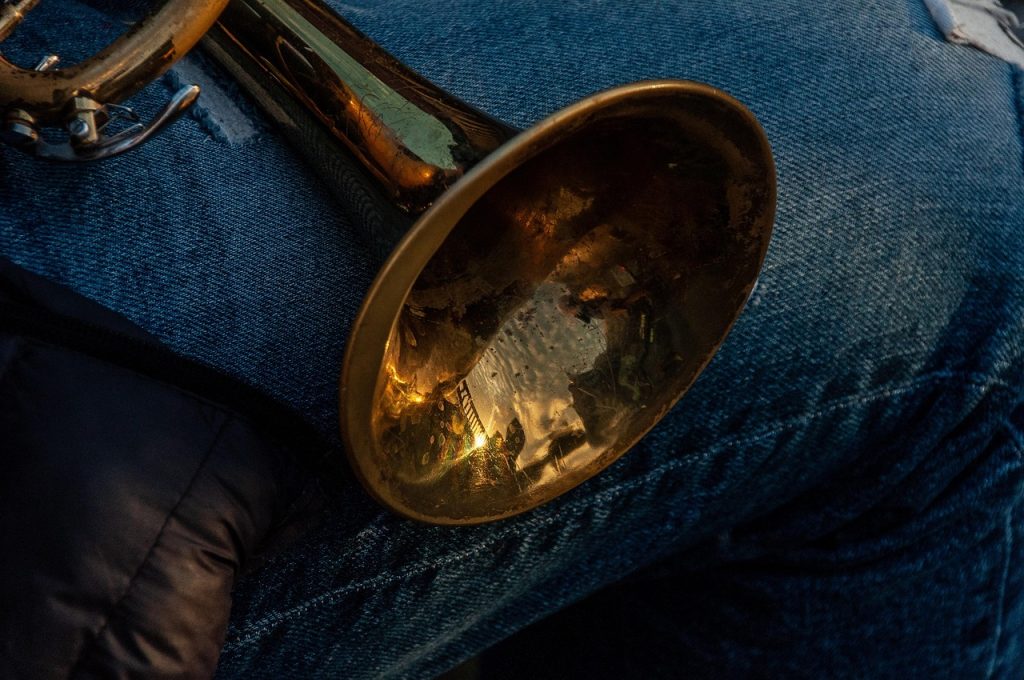
The trumpet’s bell is more than just an eye-catching feature—it serves critical acoustic functions that significantly influence the instrument’s projection and tonal characteristics.
The bell’s gradual flare efficiently transfers acoustic energy from inside the instrument to the surrounding air. According to research published in the Journal of New Music Research, this acoustic impedance transformation is maximized when the bell’s expansion follows a specific mathematical curve. Trumpet manufacturers carefully design this profile to achieve optimal sound radiation while maintaining the desired tonal characteristics.
Different bell designs produce noticeably different sound qualities. Larger bell diameters generally create darker, more symphonic sounds with greater dynamic range but potentially less projection in higher registers. Smaller bells typically produce brighter, more focused sounds that project well but may have a narrower dynamic range. According to trumpet designer Renold Schilke, the bell represents one of the most tonally influential components of the instrument.
The bell material also affects the trumpet’s sound. Some manufacturers use two-piece bells with different materials for the flare and tail, creating hybrid tonal characteristics. Others hammer or temper the bell metal to specific hardnesses, altering its vibration patterns and subsequently the instrument’s resonance properties. These subtle manufacturing variations contribute to the distinct sound profiles associated with different trumpet brands and models.
Beyond sound production, the bell also influences playability. Its reflection of acoustic energy back through the instrument creates standing wave patterns that affect response and slotting (how securely notes center). This feedback loop between player and instrument is part of what makes each trumpet unique in terms of playing feel and character.
Different Types of Trumpets and Their Mechanics
While the standard Bb trumpet remains the most common, the trumpet family includes several variants designed for specific musical contexts. Each type features mechanical adaptations that shift its fundamental pitch and tonal characteristics.
The C trumpet, pitched a whole tone higher than the Bb, has become the standard orchestral instrument in many countries. According to the Vienna Philharmonic’s instrument collection, the C trumpet’s slightly smaller dimensions create a brighter, more focused sound that cuts through orchestral textures effectively. Its shorter tubing length means the instrument resonates at slightly different harmonics, giving it a distinct tonal color from its Bb counterpart.
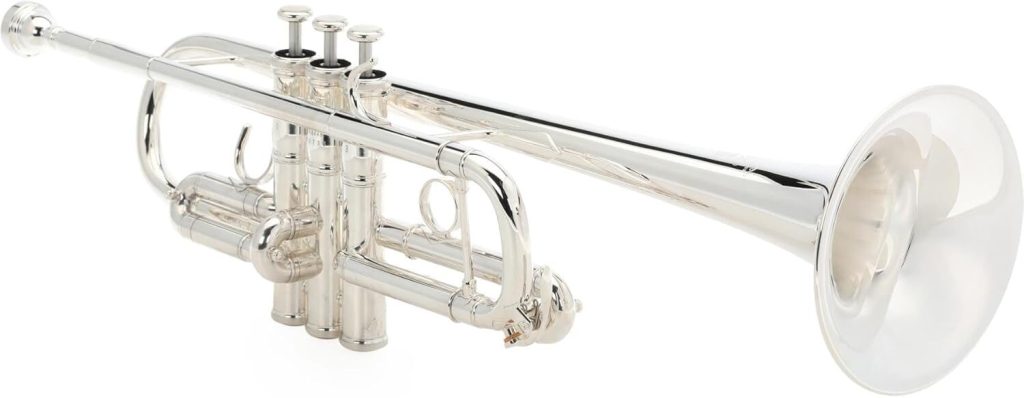
Shown above: Yamaha YTR-8445 Xeno C Trumpet
The piccolo trumpet, typically pitched in Bb but playing an octave higher than the standard trumpet, features four valves instead of three. This additional fourth valve effectively extends the instrument’s lower range, which would otherwise be severely limited due to its short tubing length. According to the Royal Academy of Music’s Historical Instrument Collection, modern piccolo trumpets evolved from Bach’s high clarino trumpets and gained popularity after being featured prominently in the Beatles’ “Penny Lane.”
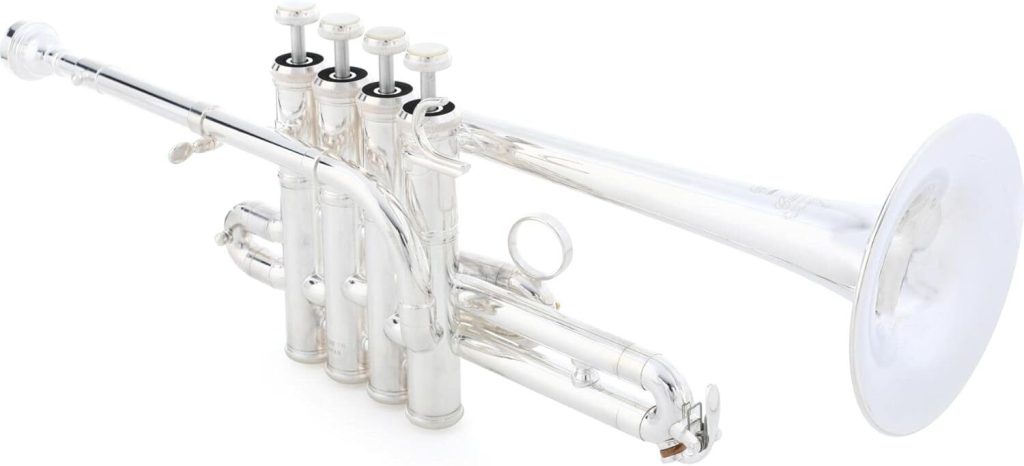
Shown above: Yamaha YTR-9835 Piccolo Trumpet
The flugelhorn, while not strictly a trumpet, shares much of its mechanical design but with significant acoustic differences. Its conical bore (gradually expanding throughout the instrument) contrasts with the trumpet’s primarily cylindrical bore. This design difference, along with its larger mouthpiece and bell, creates the flugelhorn’s distinctively warm, mellow tone. According to research from the International Horn Society, this conical bore profile emphasizes different overtones in the sound spectrum, resulting in a less brilliant but rounder tone quality.
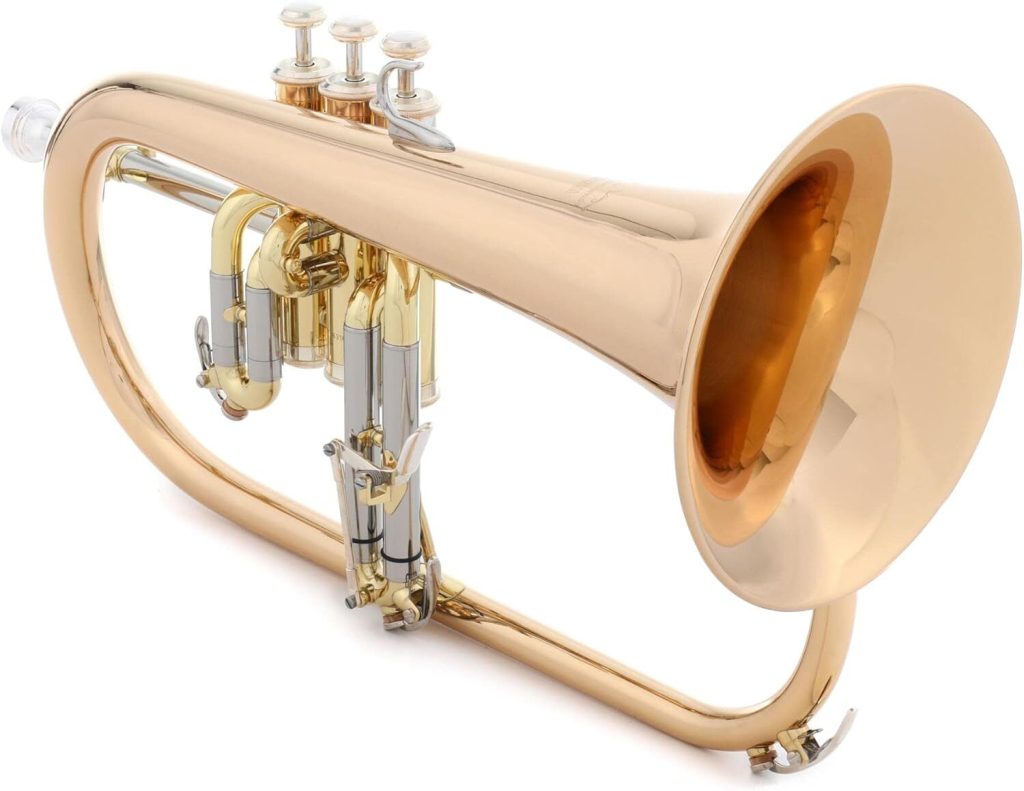
Shown above: Yamaha YFH-631G Flugelhorn
Rotary-valve trumpets, common in German orchestral traditions, replace piston valves with rotary mechanisms that turn to redirect airflow rather than moving up and down. While the acoustic principles remain identical, this mechanical difference creates subtle changes in airflow dynamics and articulation characteristics. The Deutsches Museum’s Musical Instrument Collection notes that these differences contribute to the distinctive orchestral brass sound associated with Central European orchestral traditions.
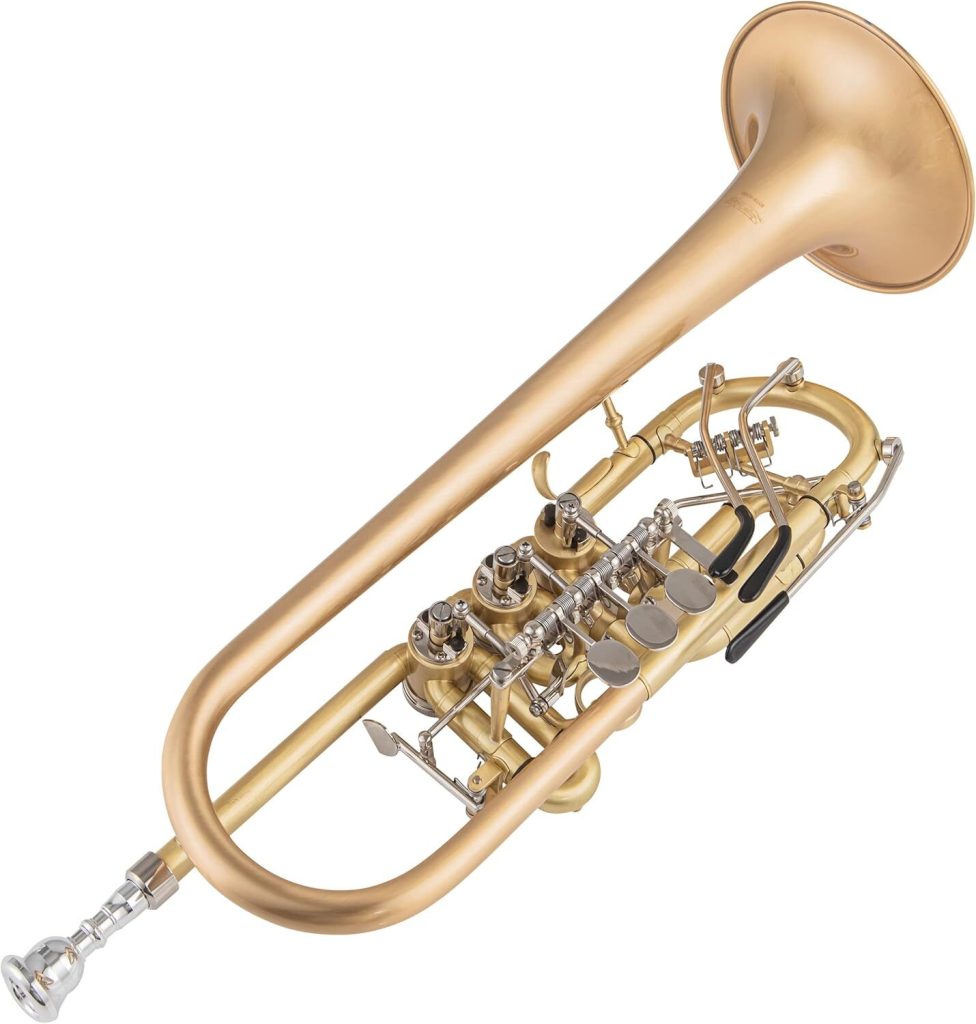
Shown above: Singer’s day SDTR-R300 C Rotary Trumpet
How Playing Technique Affects Sound Production
While the trumpet’s design creates its potential for sound, the player’s technique ultimately determines the actual sound produced. Several key aspects of playing technique directly interact with the instrument’s acoustic properties.
The embouchure—the precise configuration of facial muscles, lip position, and air support—forms the primary vibrating mechanism that energizes the trumpet. According to studies published in the Medical Problems of Performing Artists journal, trumpet players develop highly specialized muscle control involving over 50 facial muscles working in precise coordination. This muscular development allows players to fine-tune the vibration frequency and characteristics that determine pitch, tone quality, and articulation.
Air support and management significantly influence sound production. Research conducted at the Eastman School of Music demonstrates that effective trumpet playing involves complex coordination between abdominal muscles, intercostal muscles, and the diaphragm to maintain appropriate air pressure throughout different registers and dynamic levels. This coordination directly affects the energy transferred to the lips and subsequently into the instrument.
Articulation techniques—how notes are started and connected—involve precise timing coordination between air pressure, tongue movement, and valve operation. Different articulation styles (such as staccato, legato, or marcato) create their distinctive sounds through variations in these parameters. According to pedagogical research by trumpet educator James Thompson, these articulation differences occur on a time scale of milliseconds but produce dramatically different musical results.
Mute usage represents another dimension of trumpet technique that alters the instrument’s acoustic properties. Mutes partially obstruct or modify the airflow exiting the bell, changing both the sound radiation pattern and the acoustic impedance of the system. This modification affects not only the sound heard by the audience but also the feedback the player experiences, requiring subtle adjustments to playing technique to maintain proper intonation and response.
The Evolution of Trumpet Design
Today’s modern trumpet represents centuries of evolutionary development, with each innovation addressing specific musical or technical challenges. Understanding this historical progression provides context for the instrument’s current design.
Ancient trumpets date back thousands of years, with specimens found in King Tutankhamun’s tomb (circa 1323 BCE) and depicted in ancient Roman and Chinese artifacts. According to the Metropolitan Museum of Art’s Musical Instrument Collection, these early instruments were typically straight tubes without valves, limiting them to notes in the natural harmonic series. Their primary functions were ceremonial and military rather than purely musical.
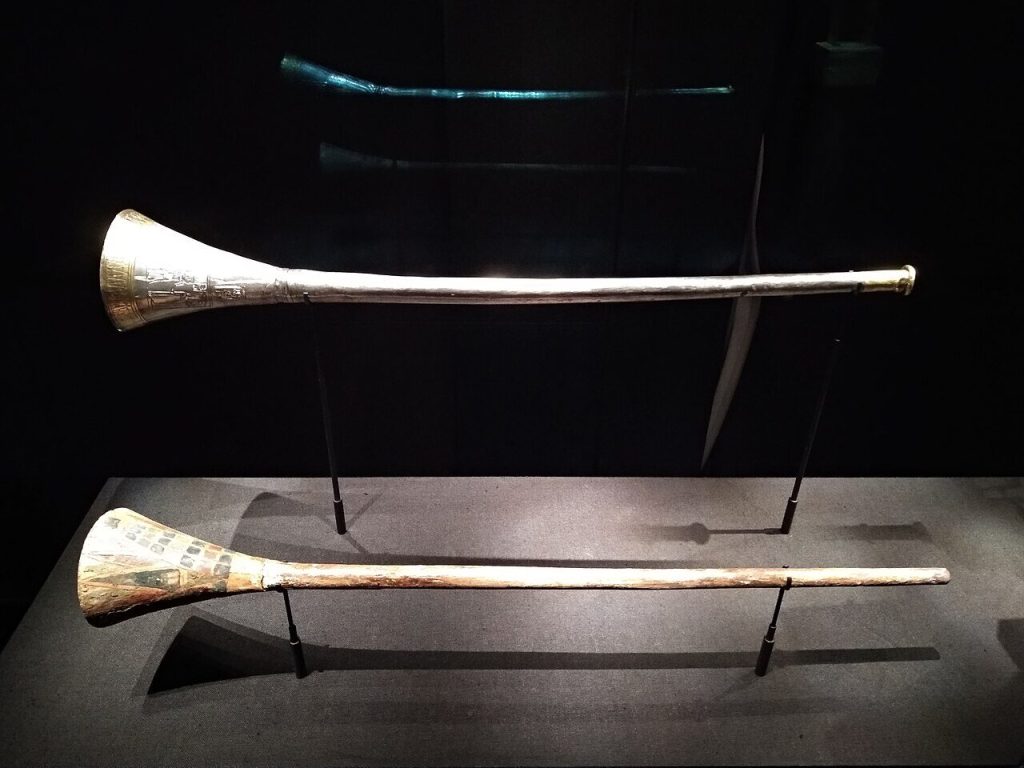
Shown above: Trumpets found in the tomb of Tutankhamun. By Suaudeau – Own work
The development of the folded trumpet design during the Renaissance period made the instrument more portable while maintaining its tube length. As documented by the Smithsonian Institution, this innovation allowed trumpets to be more easily integrated into ensemble performances, though they remained limited to natural harmonics supplemented by special “lipping” techniques to adjust pitches slightly.
The invention of valves in the early 19th century revolutionized the trumpet’s capabilities. According to music historian Edward Tarr, the first practical valve designs appeared around 1814, with significant refinements following over the next several decades. This innovation transformed the trumpet from a limited instrument to a fully chromatic one capable of playing in any key.
Throughout the 20th century, manufacturers continued refining valve mechanisms, water key designs, and bore profiles to improve intonation, responsiveness, and reliability. The National Music Museum documents how materials science advancements led to more consistent manufacturing processes and the development of specialized alloys that improved both durability and acoustic properties.
Modern innovations continue with computer-aided design and manufacturing techniques allowing for previously impossible precision in valve alignments and bore profiles. Some contemporary manufacturers integrate carbon fiber or synthetic materials for water keys, valve guides, and other components to improve durability and reduce maintenance requirements.
Acoustic Challenges in Trumpet Design
Creating a well-balanced trumpet involves navigating numerous acoustic trade-offs and engineering challenges. Understanding these inherent compromises helps explain why trumpets are designed as they are.
Intonation across all valve combinations presents perhaps the most fundamental challenge. According to acoustic research published by McGill University’s Department of Music Research, the mathematically perfect tube length for each semitone would require separate calculations for each valve combination. However, physical constraints make this impossible with just three valves of fixed length. Consequently, certain notes and valve combinations require player compensation or mechanical adjustments via tuning slides.
The trumpet’s dynamic range presents another significant design challenge. Creating an instrument capable of playing both whisper-soft passages and fortissimo fanfares requires careful balancing of bore dimensions and resistance characteristics. According to the International Trumpet Guild Research Journal, instruments optimized for the extremes of the dynamic spectrum often sacrifice versatility in other areas of performance.
Register consistency—maintaining similar tone quality and response characteristics across the instrument’s entire range—requires sophisticated bore profiling. The Journal of the Audio Engineering Society has published research demonstrating that slight variations in how the bore expands along the instrument’s length significantly affect which harmonics are emphasized in different registers, directly impacting tonal consistency.
Materials selection involves balancing acoustic properties, durability, manufacturing considerations, and cost. While brass alloys remain standard, variations in composition and treatment (like annealing and tempering) create subtle but measurable differences in an instrument’s sound and response. According to metallurgical research cited by trumpet manufacturer Bach Stradivarius, even small variations in copper content or work-hardening can noticeably influence how an instrument vibrates and consequently how it sounds.
Trumpet Care and Its Impact on Function
Proper maintenance significantly affects a trumpet’s performance, longevity, and consistency. Understanding how care practices impact the instrument’s mechanics helps players maintain optimal playing condition.
Regular cleaning prevents buildup of mineral deposits and organic matter inside the instrument. According to the National Association of Professional Band Instrument Repair Technicians, even small accumulations of debris can affect airflow dynamics and alter the instrument’s response characteristics. The narrow valve slides and water key areas are particularly susceptible to blockages that can impair proper function.
Valve maintenance directly influences playability. The precision-ground valves must move freely while maintaining airtight seals when depressed. According to maintenance guidelines from Yamaha Musical Instruments, proper lubrication with appropriate valve oils prevents both sluggish action and premature wear. Different valve materials (like monel, stainless steel, or brass) require specific lubricants formulated for their particular metallurgical properties.
Water key functionality impacts both convenience and acoustic consistency. Properly adjusted and maintained water keys allow players to quickly remove condensation that would otherwise accumulate inside the instrument. According to repair specialists at the United States Army School of Music, water accumulation not only creates distracting gurgling sounds but can also alter the acoustic properties of the instrument by effectively changing the interior dimensions of certain sections.
Chemical cleaning methods must be approached cautiously. While periodic chemical cleaning removes stubborn deposits, harsh chemicals can damage protective lacquer or silver plating and potentially alter the metal’s structural characteristics. Most instrument manufacturers, including King Musical Instruments, recommend gentle, pH-neutral cleaning solutions specific to brass instruments rather than general household cleaners or aggressive acids.
How Trumpets Compare to Other Brass Instruments
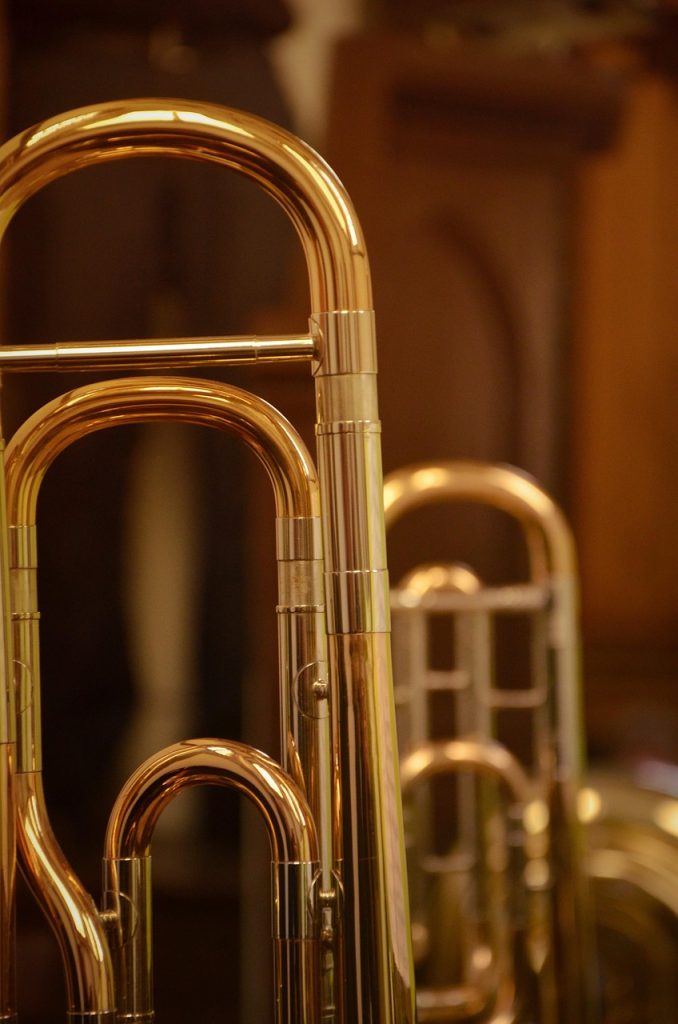
While trumpets share fundamental acoustic principles with other brass instruments, subtle differences in design create their distinctive playing characteristics and sounds. Comparing these design elements illuminates what makes each brass instrument unique.
Bore profile represents one of the most significant differences. Trumpets feature predominantly cylindrical bores that expand primarily at the bell, while instruments like flugelhorns and French horns use conical bores that expand gradually throughout their length. According to acoustic research published in the Journal of the Acoustical Society of America, cylindrical bores emphasize higher harmonics, creating brighter sounds, while conical bores emphasize fundamental frequencies and lower harmonics, producing warmer tones.
Mouthpiece design varies substantially across brass instruments. Trumpet mouthpieces typically feature relatively shallow cups with fairly small diameters, while trombone mouthpieces use deeper cups with larger diameters. According to the International Trombone Association Journal, these differences directly correspond to the instruments’ respective ranges and tonal characteristics. The deeper, larger trombone mouthpiece facilitates lower range playing while contributing to the instrument’s broader sound.
Valve mechanisms differ between trumpets and larger brass instruments. Trumpets typically use piston valves oriented vertically, while many tubas and some euphoniums use rotary valves or a combination of piston and rotary systems. The International Tuba Euphonium Association notes that these mechanical differences influence not only playing technique but also maintenance requirements and even the subtle articulation characteristics of each instrument.
Bell size proportional to instrument length creates another point of differentiation. Trumpets have relatively small bells compared to their overall tubing length, while instruments like the flugelhorn have proportionally larger bells. This ratio affects projection patterns, dynamic capabilities, and tonal development. According to acoustician Arthur Benade’s research, these proportional differences contribute significantly to each instrument’s characteristic voice within the brass family.
Trumpet Acoustics in Different Performance Spaces
The relationship between trumpet acoustics and performance environments significantly influences how the instrument sounds to both performers and audiences. Different spaces interact with the trumpet’s sound in ways that can either enhance or challenge the performance.
Reverberation time—how long sound continues after the source stops—dramatically affects trumpet playing. According to studies by the Acoustical Society of America, highly reverberant spaces like cathedrals can sustain trumpet sounds for several seconds, blending consecutive notes together. This acoustic characteristic influences articulation choices, as crisp staccato passages may become muddy while sustained passages gain resonant beauty. Conversely, acoustically “dead” spaces with minimal reverberation require players to create more sustain and resonance through their technique.
Frequency response variations in different venues also impact trumpet sound. Research from the Audio Engineering Society demonstrates that room dimensions create standing wave patterns that amplify certain frequencies while diminishing others. These room modes can make specific trumpet notes jump out unexpectedly or seem weaker than others, requiring players to adjust their dynamic balancing accordingly.
Directional characteristics of trumpet sound interact with stage placement and room design. The trumpet projects sound primarily in the direction the bell points, with high frequencies being more directional than low frequencies. According to performance space research by McGill University, this directional quality means that audience members in different locations hear noticeably different timbral qualities from the same trumpet performance, something experienced players consider when positioning themselves on stage.
Environmental conditions like temperature, humidity, and air density directly affect trumpet intonation and response. The Journal of Research in Music Education has published studies showing that even moderate changes in these variables can shift a trumpet’s pitch by several cents and alter its response characteristics. Professional players develop techniques to compensate for these environmental variations, often making subtle adjustments to tuning slides or embouchure to maintain consistent intonation.
The Future of Trumpet Design
While the fundamental design of trumpets has remained relatively stable for over a century, ongoing innovations continue to refine the instrument and potentially point toward future developments.
Material science advancements may lead to new alloy compositions specifically engineered for acoustic properties. According to research from the Materials Research Society, developments in metallurgy have created possibilities for brass alloys with enhanced vibration characteristics or improved corrosion resistance. Some experimental trumpets already use specialized alloys or composite materials for specific components like bell flares or valve casings.
Digital integration represents another frontier in trumpet development. Systems that combine traditional acoustic instruments with digital sensors and processors can extend the trumpet’s capabilities. According to the International Computer Music Association, these hybrid instruments allow performers to trigger electronic sounds, modify their acoustic output in real-time, or capture performance data for analysis and education.
3D printing technology offers potential for both customization and acoustic experimentation. Research published by the Audio Engineering Society demonstrates that 3D-printed components can be rapidly prototyped with subtle variations to test acoustic theories or tailor instruments to individual players’ preferences. While current materials limitations prevent full 3D-printed brass instruments of professional quality, the technology continues advancing rapidly.
Valve system innovations continue to address inherent intonation compromises. Alternative systems like the Schagerl Horsdorf model integrate additional compensation mechanisms that improve problematic valve combinations without requiring conscious adjustment by the player. Other experimental designs explore expanded valve configurations that provide more precise tube length adjustments for improved intonation across all playing situations.
Conclusion
The trumpet stands as a remarkable example of how scientific principles, engineering precision, and artistic expression intersect. Its seemingly simple design conceals sophisticated acoustic engineering that transforms a player’s breath and lip vibrations into powerful, expressive music capable of both delicate lyricism and roof-raising brilliance.
Understanding how trumpets work enhances appreciation for both the instrument and the musicians who master it. The complex coordination required to play the trumpet—managing breath support, embouchure formation, finger technique, and musical interpretation simultaneously—represents one of music’s most demanding technical challenges. This explains why trumpet playing develops slowly but can ultimately achieve extraordinary expressivity in skilled hands.
For those considering learning the trumpet or purchasing one, this knowledge provides valuable context for making informed decisions. Recognizing how different design elements affect sound and playability helps match instruments to personal preferences and musical goals. While no single trumpet design can be perfect for all situations, understanding these principles helps players find instruments that best suit their individual needs.
The enduring popularity of the trumpet across musical genres and throughout history testifies to its remarkable versatility and expressive power. From classical orchestras to jazz ensembles, from military ceremonies to popular music, the trumpet continues to captivate both performers and listeners with its distinctive voice—a voice made possible by the elegant marriage of physics and craftsmanship explored throughout this article.
Disclaimer: As an Amazon Associate, I earn from qualifying purchases. All product recommendations are based on research and experience rather than direct testing of every instrument mentioned. Specific prices have been omitted as they vary by retailer and change over time.

